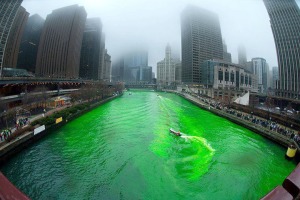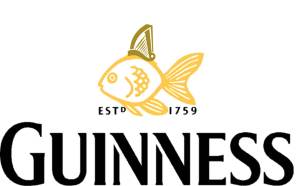By Patrick Cooney
Are you planning to enjoy a delicious Guinness or Harp beer this St. Patrick’s Day? Then be prepared to swallow bits of dead fish (seriously!).

I am currently sitting in Chicago as the river is dyed green for what I once believed was my rightful Birthday…St. Patrick’s Day. Just as I was once surprised to learn that I would not be getting presents on this day, I am now surprised to find that dead fish play a critical step in the process of making Guinness, my favorite Irish beer.

Fish swim bladders are a transparent internal fish organ that helps maintain buoyancy. These organs are dried and ground into a fine powder called isinglass. During the clarifying process (or fining process) of alcohol production, something is needed to get the suspended and cloudy bits out of suspension. Isinglass is a readily available byproduct from fish processing facilities, and is excellent at flocculating together extremely fine suspended particles (bits of yeast, malt, and barley) for separation from the liquid. The flocculant is discarded, but small bits of fish do still remain in the beer.
 Isinglass has Dutch origins, and comes from the word huizenblaas, literally meaning sturgeon (huizen) bladder (blaas). More recently, as sturgeon populations decline, isinglass is made from cod and carp species.
Isinglass has Dutch origins, and comes from the word huizenblaas, literally meaning sturgeon (huizen) bladder (blaas). More recently, as sturgeon populations decline, isinglass is made from cod and carp species.
Guinness officially states: “We do use isinglass, a byproduct of the fishing industry, for fining all Guinness brewed beers. We accept that some minor traces of isinglass may subsequently remain in the finished product. To date, we have not found any alternative that is as effective and as environmentally friendly as isinglass.”

Not all alcohol distillers, vintners, and brewers use isinglass to clarify their concoctions. In fact, synthetic gelatins are more often used than animal based products; however, just as the ingredients used to dye the Chicago River green are kept secret, ingredients used to make beer are also a close guarded secret. Therefore, it is often difficult to easily understand when isinglass is used as a clarifying agent in alcohol production, causing potential vegetarian and allergen concerns.

A website was developed to help folks, particularly vegans, determine which beers, wines, and alcohols were made using fish swim bladders. A quick filter to only include beverages made in Ireland demonstrates that isinglass is still a popular clarifying agent in that country, whereas countries outside of the United Kingdom mostly use synthetic clarifying products.
After reading this, perhaps you will find that fish play a more important role in your diet than you once imagined. Therefore, as you enjoy your smooth and delicious Irish beer this March 17th (along with your fishy peanut butter), you may consider raising your glass to the almighty fish who gave its life for your drinking pleasure…Brilliant!



With a modicum of irony, a species of red algae called Irish Moss (Chondrus crispus) is a very common clarifying agent for beer.
Мы с друзьями очень часто кидаем все и едем путешествовать по миру в поиске действительно неповторимых мест. Недавно посетили Белевский женский монастырь (Ровно) и были впечатлены парящей там атмосферой. К большому сожалению по пути домой мы забыли посетить церковную лавку и купить что-то на память, к большому счастью выручил интернет, я купила себе икону Александра Невского.
pravmir.com.ua